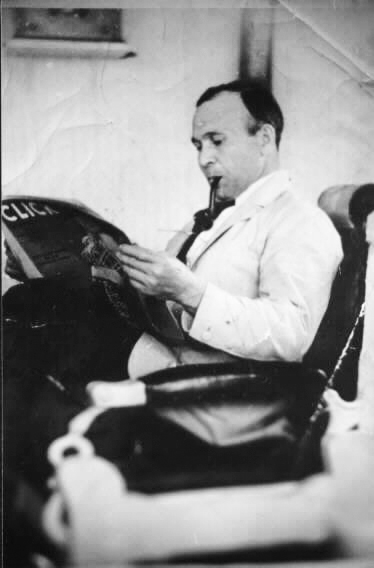By Dan Shine
Voice Columnist
Buddy’s Barber Shop
Sometime during the years just before 1920, Ray Thomas opened Thomas Garage on Washington Avenue; it was a place where he fixed flats, charged batteries, and sold nineteen-cent gasoline to owners of Model T Fords and the like.
At about the same time, an Italian immigrant named Giuseppe “Buddy” Cambino started barbering in a tiny building located next door to the garage, and right behind Pfaff’s market. It was inevitable that a friendship would develop between the two men, and that many hours would be spent together in that barber shop.

by Giuseppe “Buddy” Gambino stood on Washington Avenue, steps away from Thomas’s Garage and behind Pfaff’s Market. Getting a haircut was a time to catch up on some reading and meeting up with friends.
In those days, life didn’t offer as many diversions for men, so barber shops and hardware stores became their hangouts. Among the loafers who could be found idling their afternoons away in barber shops were all types of reprobates–and it mattered not whether those reprobates needed a haircut—often all they wanted was an opportunity to exercise a peculiar form of peer pressure best known to adult males.
Now, any student of humanity recognizes that there is a profound developmental difference between males and females: For instance, from the time they are two or three years old, little girls already play at being women, and growing up is the thing that they yearn for. By contrast, middle-aged males can typically still be found passing the time with adolescent play: taking risky dares, subjecting others to strange practical jokes, emitting crude and noxious noises, and giving each other wedgies. No matter which side you view this male-female contrast from, what you observe might be somewhat amusing.
So back to our story: by the 1930s, Buddy’s Barber Shop was frequented by many of the local males; it was a place where the air was laced with smoke from Buddy’s pipe, and heated by a pot-bellied stove; and the shop was generally filled with tall tales and the choicest local gossip. Ray Thomas, well on his way to becoming a quirky old curmudgeon of legendary stature, was one of Buddy’s most frequent “guests.”
One afternoon, when Ray entered the barber shop, the other men were ready to ambush him. They bet Ray that he couldn’t touch his finger to his nose and walk out the door of the barber shop. Ray laughed and assured them he could. He accepted the dare, put his finger to his nose, and prepared to walk out the door.
“Not so fast, Ray,” someone said. The men guided him over to the pot-bellied stove, wrapped his elbow around the stove’s smoke pipe, and placed his fingertip on his nose. “Now you’re ready to walk out the door.” Impossible–right? Not for Ray Thomas. A moment later, he could be seen dragging the stove through the barber shop door, with hot coals spilling from the stove’s open front. For the men, the hilarity of tricking Ray had backfired; now they had to deal with the consequences, and put out the burning coals and cinders, which had set the barber shop on fire. Meanwhile, Ray Thomas stood out on the sidewalk next to the stove, smoking his pipe and smiling wryly; he was quite pleased with himself, for he had fought the odds, he had persevered, and through diligence and hard work, he had won the bet.
Ray Thomas and Buddy Cambino remained friends and neighbors for a few decades after that—both lived on Sawmill Road, and both worked on Washington Avenue—and many other pranks were pulled along the way. And although they both departed this life many years ago, it is fitting that they should be remembered through such humorous tales, so many years later.